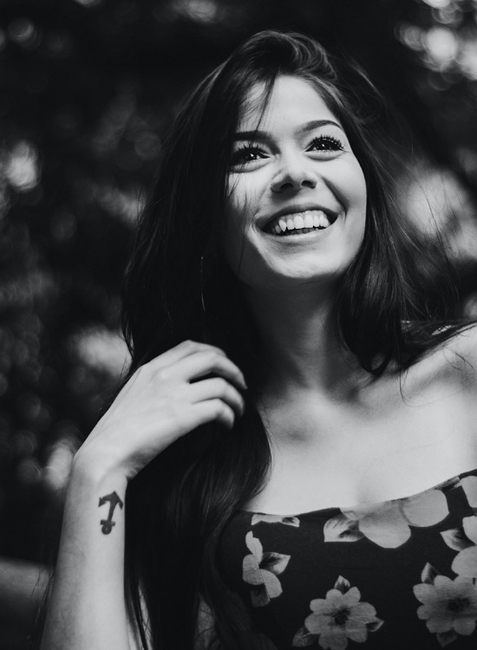Monochrome photos are an excellent way to turn an everyday image into a work of art. Shutterbugs familiar with black and white photography techniques will find comfort in this artform, as they share many attributes.

The great thing about monochromatic pictures is that there are no rules. They can add an abstract and singular look to a piece, but the idea of sharing a color throughout the frame can be used for any aspect of composition. Read our article for great photography composition tips and techniques. It can even be applied to things like portraiture.
What Are Monochrome Colors?
If something is monochromatic, it contains just one color. When we talk about monochromatic colors, we are referring to all of the hues of one color.
For example, most people are familiar with black and white photography. But when you consider what makes those two colors, they are simply hues of grey. The range of grey goes from dark black to white. A black and white photo contains hundreds or thousands of hues of grey.
Colors are made up of many shades, tones, and tints. When you take one color like pure red, and add a little black, you begin creating shades of red. The more black you add, the darker it will get. From here, you will create colors like maroon. If you add grey, you can create tones of red. And finally, if you add white, you will create tints of red like pink.
Many designers use a monochromatic color scheme when they want to make a design clean and simple. It adds elegance to the design, and by removing color data from the image or layout, it focuses the viewer’s attention more clearly on the subject and content.
Don’t assume that monochromatic images are boring or stagnant. They can lend a dynamic feel that imparts more emotion than a standard full-color frame.
And for the record, a multicolor image is appropriately called a polychrome photo.

What is Monochromatic Color Photography?
In photography, a monochromatic color scheme is one that only features one color in the frame.
In the early days of photography, the chemical processes that made photographs lent themselves to monochromatic images. Sepia or brownish images were the norm. Eventually, technology evolved to make sharp black and white prints a reality. When we see sepia images now, they instantly remind us of something historical–it must be old to look like that.
But many photographers enjoy the look of a sepia and black and white photos today, even with the prevalence of digital full-color photography. It’s an easy way to step back in time and to make your photos have a more significant impact on your audience.
With a digital camera, most photographers now create monochrome effects in post-production instead of at the time of capture. In Photoshop, it’s easy to convert a photo into any color palette you desire.
Why Do Photographers Use Monochromatic Colors?
With so many other options available to photographers, it might not be readily apparent why anyone would bother with a monochromatic color scheme. But many photographers choose to work and edit in this style.

Novelty and Abstraction
One of the most apparent reasons for making a monochromatic image is that the result is so unique. You’re no longer capturing the world as it is, but rather how you want it to appear. While that might be the goal of all of your photography, your viewers will instantly understand it when seen in monochrome. It’s obviously not reality, so it’s up to them to interpret what they see.
Simplicity
Graphic designers use one-color layouts often because they’re simpler designs. That’s an important tool to have when a design is complicated. Think about detailed infographics you’ve seen, or intricate patterns and artwork. More often than not, the more details something has, the fewer colors the designer will choose to use. Why? Because removing colors instantly simplifies a design, and adding colors adds complexity.

Emotional Reaction
Finally, colors cause a subconscious psychological reaction. We all have these reactions, whether we realize it or not. Here are just a few examples.
Red is the color of passion, be they love, anger, or even hate. Blood is red. Reddened flushed cheeks give away our deepest emotions. All of this means that red is deeply related to ourselves and our human interactions. It’s usually associated with negative emotions or warnings and can make a person feel uneasy or give them a sense of unrest.

Yellow is another powerful color, but it’s usually associated with happiness, joy, and sunshine. It reminds us of gold. Since it contrasts with most things, it’s used for high-visibility highway stripes and road signs. If there’s too much of it in a scene, it can be too confusing, but it communicates mostly positive emotions.
Orange is a mixed bag, however. Since it shares a little red and a little yellow, you get the results of both. It speaks to healthfulness or strength and reminds us of sunsets or fall-time colors. For some, it is a warm feeling of sitting by a campfire, while others are made uneasy by the color.

Green reminds us of nature, healthy growth, and peace. It’s calming and appealing.

Blue shares much the same features since it is also found in nature. Blue is the color of water and the ocean. Blue and green are closely related, and many people identify blue as their favorite color.

Likewise, pink and purple are closely related. Pink reminds us of spring, flowers blooming, and femininity. It’s a soft color full of joy and possibility. Purple shares some of these characteristics, but is darker and more regal. Incidentally, purple was often associated with royalty since it was a rare and special pigment.
Tips to Create Monochromatic Colors in Photography
Plan the Composition
The best single-color images don’t just get put together in post. They are planned from the beginning. Perhaps you see an image that you like, and it reminds you of a color. Or a prominent color in a scene gives you a powerful reaction that you want to share with your viewers. With the color in mind, you can frame your picture logically to maximize its effect.

Even though the picture isn’t monochromatic yet, it’s ready to go as soon as you get it into your favorite photo editing program. We had put together top app for photo editing based on the photo app features, their ease-of-use, and social sharing capabilities.
That isn’t to say that you can’t get great results by playing around with old images on the computer. It merely means that the best images are the ones you plan for.
Pick Your Subject
Obviously, the color is a powerful part of the message you want to communicate. But what is the subject of the photo? It’s easy to figure out in portrait photography, but in other instances, it might not be so certain. Sometimes, you might like the scene and the color, but not have a subject. The fact that you are going to make it into a monochrome composition means you have a little flexibility. The color is going to speak for itself no matter what you choose. Regardless, you want something for the viewer to see; you want something that the color draws attention to.
Master Contrast
For a single-color composition to really pop, the range of tones in the image needs to be just right. Use the histogram tool on your camera or editing software to view how the light is distributed. There should be a bell-shaped curve, evenly distributed with sufficient blacks and whites.
To correct it, use the curves tool. Curves allow you to modify the histogram directly. If it’s too far one way or another, you can drag it around until the curve is centered. You can also drag the mid-range tones up or down to bring out details in the image.
There are no hard and fast rules when making these adjustments since every image is different. Just remember that you are removing the color data from the photo, so the contrast of tones is all that will remain. If the histogram doesn’t have a nice curve to it, then the picture will likely be very flat when you remove the color.
You can think of this in terms of a sunset photograph. If you remove all of the color data from a beautiful sunset, what is left? Probably just a grey and white palette that is indiscernible. If, however, there are clouds in the sky and lots of dark and light areas of detail, you’ll be able to see what is there without the color.
Find Contrast
The best way to keep your monochrome pictures interesting is to use textures and patterns where ever you find them. Lines, shapes, and angles all form areas of contrast that add to a photo. These are the things that are going to remain noticeable after the color data is removed.

Choose Your Color
The choice of what color to use shouldn’t be completely random. If you’re going through old photos on your hard drive and playing with the monochromatic color wheel in your editing program, you can play around as much as you like. But as mentioned previously, the best compositions result from some planning.
If you’ve got a photo you think would look great in monochrome, sit back for a moment and consider your color options. Is there something in the frame that speaks to you, that you want to draw out? Or does the image make you feel a certain way that you want to emphasize, or even negate? Consider the colors available to you, and try out a few different ones. Print out the results and look at them, each with a fresh set of eyes. This method is the single best way to learn how the colors will affect the image and its reception.
One of the hardest parts of shooting monochrome or black and white images is the visualization of the final product. These simple tips are a starting point to get you started, but the only real way to learn how to make good ones is to go out and practice.
How to Turn a Full-Color Image Into Monochrome?
Any good photo editing software will allow you to create a monochrome picture. The process is a simple one. But the key to getting great results is to always start with the right image. Not every picture can be converted into any color, and not every image should be made into a single-color version.
The first step is to convert your image to greyscale. Once the color data has been removed, you can adjust it for the best contrast and tonal range. You can use your program’s exposure sliders or use the curves tool. The goal is for there to be a good spread of tones, from dark blacks to white whites. Shadows should be clear and conspicuous. It might be a little more contrast-heavy than you are used to.
The next step is to convert the image to a duotone. Once that is done, the second color can be altered to whatever color you want to use in your monochrome image. Alternatively, you could add a color layer on top of your greyscale image and adjust the layer settings to get the effect you’re after.
Most programs have a monochromatic color wheel that you can use to adjust the ones in the photo until they are just right.
Monochromatic Portrait Photography
There are two main ways you can apply monochrome techniques to portrait photography. You could go all in and create an actual monochromatic image. It could be a black and white image, or it could be colored by gel lighting or post-production editing.
The most common monochrome portrait is the black and white. These are still very common–black and white portraits are classy and professional. Many people consider fine black and whites to be works of art, and taking a good one is tricky. The amount of attention required to master the tones and contrast in the image is different than snapping a polychrome photo.
Alternatively, you could take a standard full-color portrait but apply some monochromatic ideas to the composition. In this way, you won’t be altering a person’s skin tones or hair colors. The photograph will be an accurate representation of the person. But there are other elements you could play with to significant effect. The most prominent items that photographers play with are the background and the wardrobe.
While these two simple items might sound ridiculously simple, they can have a powerful effect on the portrait when viewed as a whole. If all items of the person’s wardrobe match all of the other non-human elements in the composition, more focus is placed on your subject. It also makes it immediately apparent that the composition was well thought out and planned. It’s a sharp look, and it will elevate even the most straightforward portrait jobs to another level.
A typical example of this is the formal portrait session, with a black outfit and a simple grey background. Skin tones, eyes, and hair color pop out of the photo because there is nothing else distracting. There’s plenty of tonal range thanks to the person’s skin tones, and the background can be adjusted accordingly to add or remove depth, details, or interest.

And of course, all of the other tenets of portraiture remain constant. But if any props or other items are included, the goal should be for all elements to be monochromatic.
How is Black and White Photography Different From Monochrome Photography?
Black and white photography is just one form of shooting monochromatic images. It is the form that most people are most familiar with, and everyone has seen a black and white photo at one point or another.
When you break it down, a black and white photograph is a monochrome image using grey. There are lots of hues of grey used, from black all the way to white.

Other monochrome images work the same way. Instead of grey, they use one color that ranges from dark black to white. The primary color is blue, red, orange, or another example on the monochromatic color wheel.
Conclusion
Monochrome images range from classic and timeless black and whites to abstract avant-garde compositions. The artistry of the photographer becomes apparent if they know when to use which technique. When applied to the right photograph at the right time, the look of a monochrome can add an unmatched uniqueness to your composition.
Do remember to showcase your collection on your portfolio website. With our handy guide on how to build your portfolio website, you can start today. Make sure that the portfolio website builder you choose offers the flexibility, features, and ease-of-use you need to put together a professional portfolio website without requiring any coding knowledge. Pixpa is a portfolio website builder platform that is trusted by creative pros around the world. Have a look at some stunning portfolio website examples.
Create your professional portfolio website easily on Pixpa in minutes without any coding knowledge. Start your free trial now.














